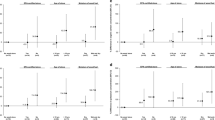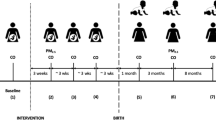Abstract
During the first randomized intervention trial (RESPIRE: Randomized Exposure Study of Pollution Indoors and Respiratory Effects) in air pollution epidemiology, we pioneered application of passive carbon monoxide (CO) diffusion tubes to measure long-term personal exposures to woodsmoke. Here we report on the protocols and validations of the method, trends in personal exposure for mothers and their young children, and the efficacy of the introduced improved chimney stove in reducing personal exposures and kitchen concentrations. Passive diffusion tubes originally developed for industrial hygiene applications were deployed on a quarterly basis to measure 48-hour integrated personal carbon monoxide exposures among 515 children 0-18 months of age and 532 mothers aged 15-55 years and area samples in a subsample of 77 kitchens, in households randomized into control and intervention groups. Instrument comparisons among types of passive diffusion tubes and against a continuous electrochemical CO monitor indicated that tubes responded nonlinearly to CO, and regression calibration was used to reduce this bias. Before stove introduction, the baseline arithmetic (geometric) mean 48-h child (n=270), mother (n=529) and kitchen (n=65) levels were, respectively, 3.4 (2.8), 3.4 (2.8) and 10.2 (8.4) p.p.m. The between-group analysis of the 3355 post-baseline measurements found CO levels to be significantly lower among the intervention group during the trial period: kitchen levels: −90%; mothers: −61%; and children: −52% in geometric means. No significant deterioration in stove effect was observed over the 18 months of surveillance. The reliability of these findings is strengthened by the large sample size made feasible by these unobtrusive and inexpensive tubes, measurement error reduction through instrument calibration, and a randomized, longitudinal study design. These results from the first randomized trial of improved household energy technology in a developing country and demonstrate that a simple chimney stove can substantially reduce chronic exposures to harmful indoor air pollutants among women and infants.
This is a preview of subscription content, access via your institution
Access options
Subscribe to this journal
Receive 6 print issues and online access
$259.00 per year
only $43.17 per issue
Buy this article
- Purchase on Springer Link
- Instant access to full article PDF
Prices may be subject to local taxes which are calculated during checkout




Similar content being viewed by others
References
Albalak R., and Bruce N., et al. Indoor respirable particulate matter concentrations from an open fire, improved cookstove, and LPG/open fire combination in a rural Guatemalan community. Environ Sci Technol 2001: 35 (13): 2650–2655.
Amendariz-Arnez C., and Edwards R.D., et al. Reduction in personal exposures to particulate matter and carbon monoxide as a result of the installation of a Patsari improved cook stove in Michoacan Mexico. Indoor Air 2008: 18: 93–105.
Bhangar S., and Smith K.R., et al. The contribution of stove type to the variability in CO concentration in households in rural Maharashtra, India. International Society of Exposure Science, Annual Meeting, Philadelphia 2004.
Bruce N., and McCracken J., et al. Impact of improved stoves, house construction and child location on levels of indoor air pollution exposure in young Guatemalan children. J Expo Anal Environ Epidemiol 2004: 14 (Suppl 1): S26–S33.
Bruce N., and Weber M., et al. Pneumonia case-finding in the Guatemala indoor air pollution trial (RESPIRE): standardizing methods for resource-poor settings. Bulletin of the WHO 2007: 85 (7): 535–544.
Chengappa C., Bajpai R., Gusain P.P.S., Edwards R.D., Naumoff Shields K., and Smith K.R. Impact of improved cookstoves on indoor air quality in the Bundelkhand Region in India. Energy Sustainable Dev 2007: XI (2): 33–44.
Delfino R.J., and Quintana P.J., et al. Association of FEV1 in asthmatic children with personal and microenvironmental exposure to airborne particulate matter. Environ Health Perspect 2004: 112 (8): 932–941.
Dherani M., and Pope D., et al. Indoor air pollution from unprocessed solid fuel use and pneumonia risk in children aged under 5 years: a systematic review and meta-analysis. Bulletin of the WHO 2008: 86 (5): 390–398.
Dutta K., Naumoff Shields K., Edwards R.D., and Smith K.R. Impact of improved cookstoves on indoor air quality in rural homes near Pune, India. Energy Sustainable Dev 2007: XI (2): 19–32.
Eilers P.H.C., and Marx B.D. Flexible smoothing using B-splines and penalized likelihood. Statistical Science 1996: 11 (2): 89–121.
Hruba F., and Fabianova E., et al. Childhood respiratory symptoms, hospital admissions, and long-term exposure to airborne particulate matter. J Expo Anal Environ Epidemiol 2001: 11 (1): 33–40.
Masera O.R., Edwards R.D., Armendáriz Arnez C., Berrueta V., Johnson M., Rojas Bracho L., Riojas-Rodríguez H., and Smith K.R. Impact of “Patsari” improved cookstoves on indoor air quality in Michoacan, Mexico. Energy Sustainable Dev 2007: XI (2): 45–56.
McCracken J.P., and Albalak R., et al. Improved stove or inter-fuel substitution for decreasing indoor air pollution from cooking with biomass fuels in highland Guatemala. Indoor Air 1999: 3: 118–123.
McCracken J.P., and Schwartz J., et al. Combining individual- and group-level exposure information: child carbon monoxide in the Guatemala woodstove randomized control trial (RESPIRE). Epidemiology 2009: 20 (1): 127–136.
McCracken J.P., and Smith K.R. Emissions and efficiency of improved woodburning cookstovs in highland Guatemala. Environ Int 1998: 24 (7): 739–747.
Mehta S., and Gore F., et al. Modeling household fuel use toward reporting of the Millennium Development Goal indicator. Energy for Sustainable Development 2006: 10 (3): 36–45.
Naeher L.P., and Brauer M., et al. Woodsmoke health effects: a review. Inhal Toxicol 2007: 19 (1): 67–106.
Naeher L.P., and Leaderer B.P., et al. 2000a Particulate matter and carbon monoxide in highland Guatemala: indoor and outdoor levels from traditional and improved wood stoves and gas stoves. Indoor Air 10 (3): 200–205.
Naeher L.P., and Smith K.R., et al. 2000b Indoor and outdoor PM2.5 and CO in high- and low-density Guatemalan villages. J Expo Anal Environ Epidemiol 10 (6 Part 1): 544–551.
Naeher L.P., and Smith K.R., et al. Carbon monoxide as a tracer for assessing exposures to particulate matter in wood and gas cookstove households of highland Guatemala. Environ Sci Technol 2001: 35 (3): 575–581.
Saksena S., and Thompson L., et al. Indoor Air Pollution and Exposure Database: Household Measurements in Developing Countries. V1.1. Retrieved Apr 18 2009 from http://ehs.sph.berkeley.edu/hem/page.asp?id=33, 2003.
Sarnat J.A., and Long C.M., et al. Using sulfur as a tracer of outdoor fine particulate matter. Environ Sci Technol 2002: 36 (24): 5305–5314.
Smith K.R. Biofuels, Air Pollution, and Health: A Global Review. Plenum, New York, 1987.
Smith K.R., and Bruce N., et al. Symposium: RESPIRE- the Guatemala Stove Intervention Trial. Epidemiology 2006: 17 (6): S44–S46.
Smith K.R., and Mehta S., et al. Indoor smoke from household solid fuels. In: Ezzati, M.R., Lopez, A., Murray, C. (Eds.). Comparative quantification of health risks: Global and regional burden of disease due to selected major risk factors. World Health Organization, Geneva, 2004.
Smith K.R., and Samet J.M., et al. Indoor air pollution in developing countries and acute lower respiratory infections in children. Thorax 2000: 55 (6): 518–532.
Venkataraman C., and Maithel S., et al. Biomass-fuel Technologies for Cooking. In: Banerjee, R., Sagar, A. and Smith, K.R. (Eds.). Development Benefits of Clean Energy in India. Indian Institute of Technology, Mumbai, 2007.
WHO. Air Quality Guidelines. Global Update 2005. Particulate matter, ozone, nitrogen dioxide and sulfur dioxide, World Health Organization, Copenhagen, 2006.
Zanobetti A., and Schwartz J., et al. Airborne particles are a risk factor for hospital admissions for heart and lung disease. Environ Health Perspect 2000: 108 (11): 1071–1077.
Acknowledgements
We are grateful for the dedication and cooperation of all study participants as well as colleagues, staff and fieldworkers of RESPIRE, particularly Aura Morales, Anaité Díaz and Byron Arana. We acknowledge also valuable advice for this paper from Joel Schwarz, Ryan Johnson, Barry Ryan and Alisa Jenny. We appreciate the cooperation of the Guatemala Ministry of Health and funding by the US National Institute of Environmental Health Sciences (NIEHS no. R01ES010178), the World Health Organization, Geneva and the AC Griffin Family Trust.
Author information
Authors and Affiliations
Corresponding author
Ethics declarations
Competing interests
The authors declare no conflict of interest.
Rights and permissions
About this article
Cite this article
Smith, K., Mccracken, J., Thompson, L. et al. Personal child and mother carbon monoxide exposures and kitchen levels: Methods and results from a randomized trial of woodfired chimney cookstoves in Guatemala (RESPIRE). J Expo Sci Environ Epidemiol 20, 406–416 (2010). https://doi.org/10.1038/jes.2009.30
Received:
Accepted:
Published:
Issue Date:
DOI: https://doi.org/10.1038/jes.2009.30
Keywords
This article is cited by
-
Fossil fuel dependence and energy insecurity
Energy, Sustainability and Society (2022)
-
Evidence for reduced performance discrepancy of improved cookstoves at laboratory and field
Air Quality, Atmosphere & Health (2022)
-
Visualization and analysis of mapping knowledge domains for the global transition towards clean cooking: a bibliometric review of research output from 1990 to 2020
Environmental Science and Pollution Research (2022)
-
The effect of clean cooking interventions on mother and child personal exposure to air pollution: results from the Ghana Randomized Air Pollution and Health Study (GRAPHS)
Journal of Exposure Science & Environmental Epidemiology (2021)
-
Air pollution dispersion from biomass stoves to neighboring homes in Mirpur, Dhaka, Bangladesh
BMC Public Health (2019)



